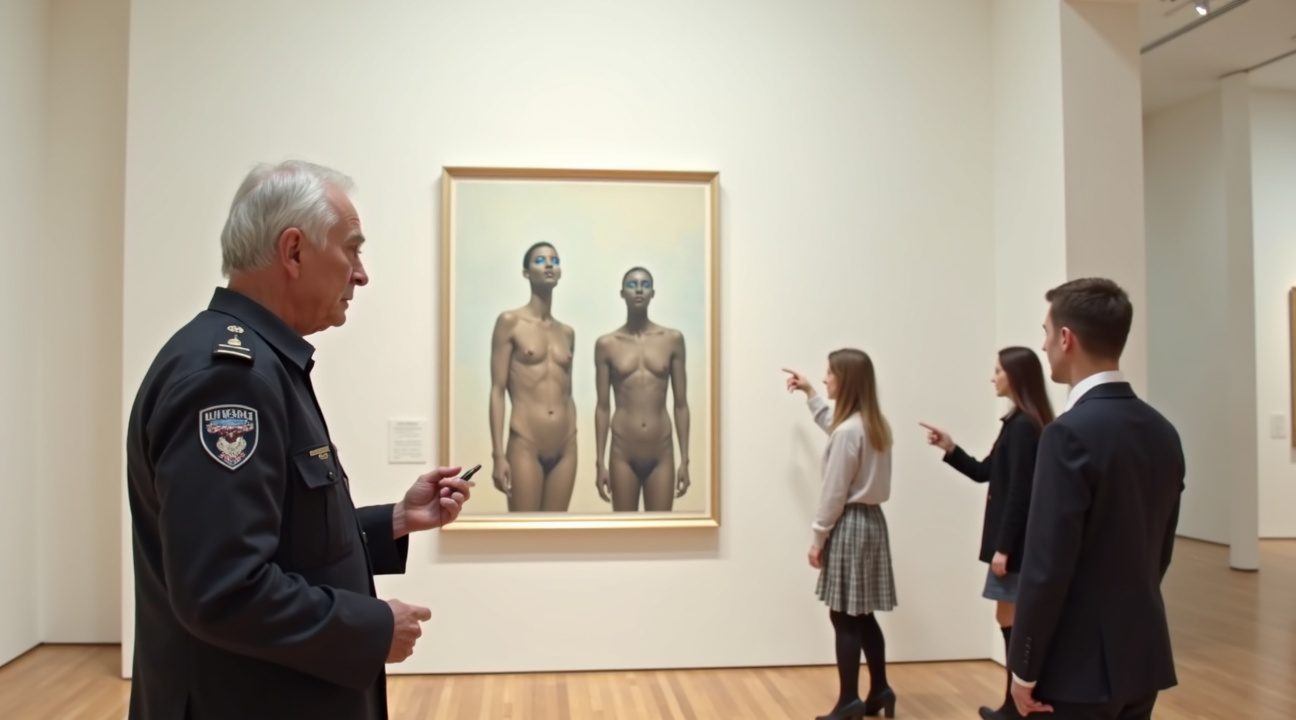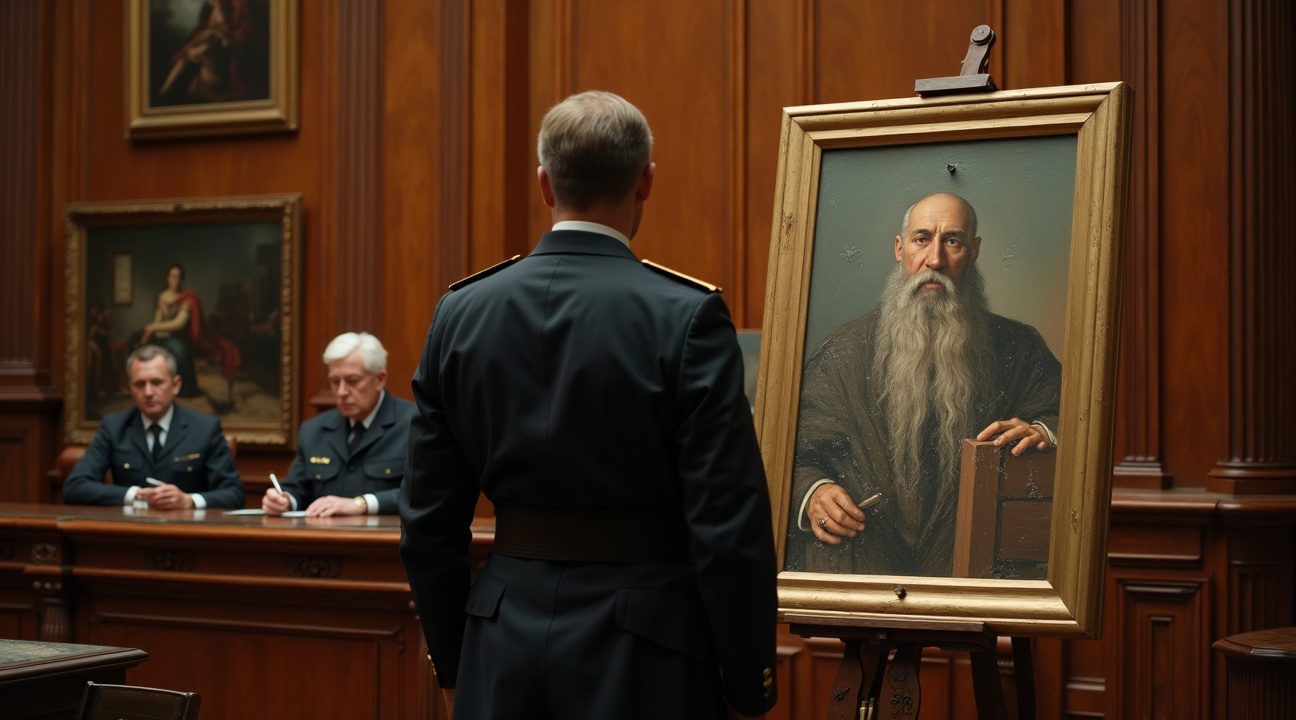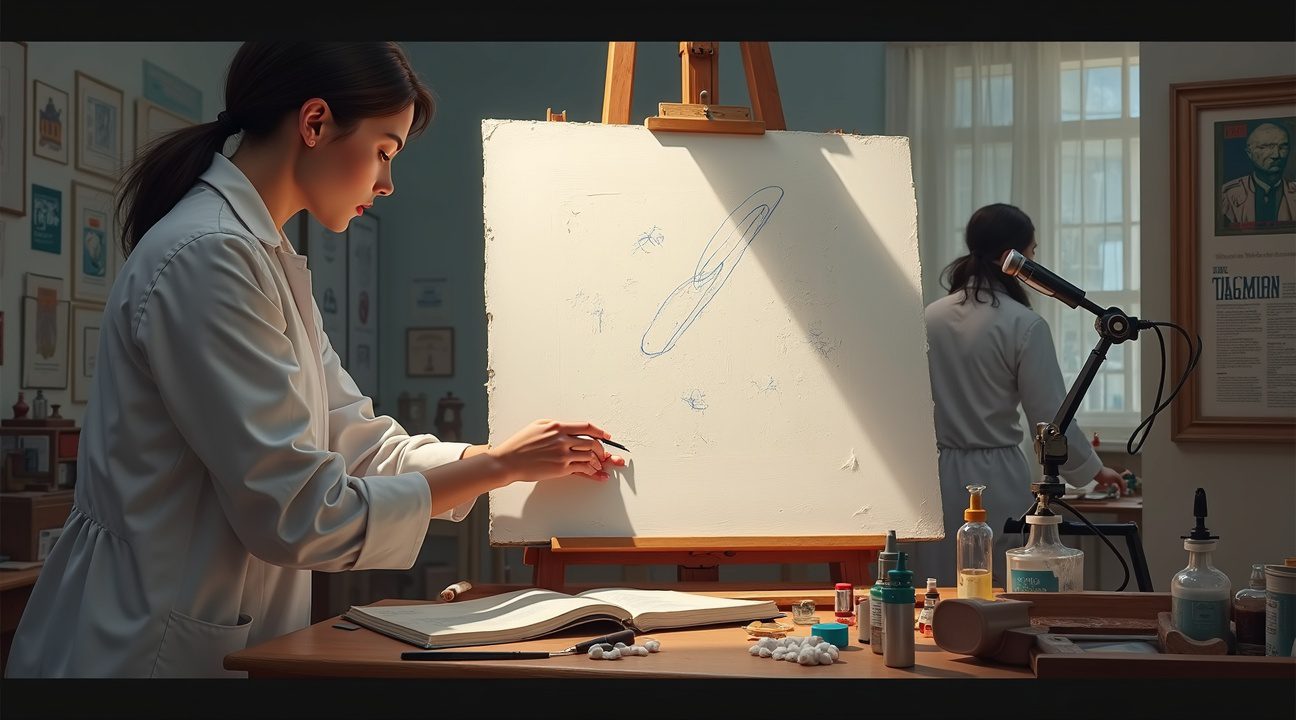A 60-year-old security guard shocked the art world when he vandalized Anna Leporskaya’s million-dollar painting “Three Figures” at the Boris Yeltsin Presidential Center in Russia.
Incident Overview
The incident took place on the guard’s first day of work. Out of what he described as boredom, he drew eyes with a ballpoint pen on the previously faceless figures in the 1932–1934 painting. The artwork, created by renowned Soviet avant-garde artist Anna Leporskaya, is valued at approximately $1 million.
Details and Legal Ramifications
The consequences for the security guard are severe. He now faces criminal charges which could result in fines ranging from €468 to $1 million. Additionally, he risks up to one year of correctional labor or a three-month prison sentence.
Restoration and Museum Response
Fortunately, the ink from the pen only affected the surface layer of the canvas, allowing for complete restoration at an estimated cost of just $3,400. Despite the lower repair cost, the museum treated the matter with utmost seriousness.
Immediate Actions Taken:
- The guard was promptly dismissed from his position following the incident.
- Protective glass screens were installed around other valuable exhibits to prevent future damage.
Global Implications
This bizarre event has prompted museums around the world to reconsider their internal security strategies. While external threats are usually anticipated, this case exposes the equally real danger of insider threats.
Key Takeaways:
- Criminal penalties include fines and potential imprisonment or correctional labor.
- The painting, although damaged, is restorable due to minimal ink penetration.
- The museum responded swiftly with disciplinary and protective measures.
- Museums are now reassessing staff training and internal safeguards worldwide.
- Anna Leporskaya’s limited body of work enhances the cultural loss such incidents represent.
Each of Leporskaya’s works is a treasured piece of Soviet avant-garde history, making their preservation a matter of cultural as well as artistic importance.
Security Guard Vandalizes $1 Million Painting on First Day with Ballpoint Pen
A shocking incident unfolded at the Boris Yeltsin Presidential Center in Yekaterinburg, Russia, when a 60-year-old security guard vandalized a valuable artwork during his very first shift. The guard, employed by a private security company, permanently altered Anna Leporskaya’s painting “Three Figures” by drawing eyes on two of the three faceless figures using a museum-branded ballpoint pen.
The Damaged Artwork and Its Value
“Three Figures,” created by Anna Leporskaya between 1932 and 1934, carries substantial monetary and cultural significance. The painting holds an insurance value of 74.9 million Russian Rubles, translating to approximately $1 million or €1 million. This avant-garde work featured three distinctive faceless figures—a deliberate artistic choice that the guard irreversibly modified with his unauthorized additions.
The damage came to light when two observant museum visitors noticed the alterations and immediately alerted gallery staff. Museum officials quickly confirmed that someone had indeed defaced the original artwork, leading to swift action against the responsible party.
Guard’s Motivation and Immediate Consequences
According to reports, the security guard’s motivation stemmed from simple boredom during his shift. Rather than maintaining professional vigilance over the precious collections, he chose to “improve” what he apparently viewed as an incomplete artwork. His actions demonstrated a fundamental misunderstanding of both his professional responsibilities and the artistic integrity of the piece.
The consequences were immediate and severe. Museum officials terminated the guard’s employment as soon as they identified him as the culprit. His private security company also faced scrutiny for their employee’s actions, raising questions about proper training and supervision protocols for personnel working in cultural institutions.
This incident highlights the critical importance of comprehensive training for security staff in museums and galleries. While guards protect valuable artworks from external threats, they must also understand their role as custodians rather than critics or improvers of the collections they’re entrusted to safeguard.
The case serves as a stark reminder that even well-intentioned actions can result in devastating cultural and financial losses. Art restoration experts will now need to assess whether the ballpoint pen damage can be reversed without further compromising the painting’s integrity. Such incidents have become increasingly rare in professional museum settings, making this particular case all the more shocking to the art community.
The Boris Yeltsin Presidential Center now faces the challenging task of determining restoration options while implementing additional safeguards to prevent similar incidents. This event will likely influence security protocols at cultural institutions worldwide, much like how major cultural moments reshape industry standards.

Criminal Charges and Potential Million-Dollar Fine
The security guard now faces serious criminal charges for vandalism that could dramatically alter his life. Russian authorities haven’t taken this art defacement lightly, and the legal consequences reflect the severity of damaging a million-dollar masterpiece.
Hefty Financial Penalties Await
If convicted, the guard could receive fines ranging from 40,000 to 74.9 million Russian Rubles. This translates to roughly €468 up to $1 million, depending on how the court assesses the damage and circumstances. The wide range gives judges considerable discretion in determining punishment based on factors like intent, the artwork’s value, and restoration costs.
Beyond financial penalties, the guard faces additional consequences that could significantly impact his freedom. He might receive up to one year of correctional labor or serve up to three months in prison. These penalties underscore how seriously Russian law treats cultural vandalism, especially when it involves internationally significant artworks.
Museum’s Response and Recovery Efforts
The incident prompted immediate security changes at the facility. Museum officials installed protective screens around remaining artworks to prevent future vandalism attempts. This reactive measure, while necessary, highlights how one person’s momentary lapse in judgment can force institutional changes that affect visitor experiences for years to come.
The restoration process involves collaboration between the Yeltsin Center and the Tretyakov Gallery, bringing together expertise from multiple institutions. Private insurer AlfaStrakhovanie is covering the restoration costs, which removes the immediate financial burden from the museum but demonstrates the ripple effects of such incidents on the art insurance industry.
Art restoration specialists will need to carefully remove the ballpoint pen marks without damaging the original paint beneath. The process requires specialized techniques and materials, making it both time-consuming and expensive. Even with successful restoration, the artwork’s provenance now includes this vandalism incident, potentially affecting its future value and exhibition history.
The case serves as a stark reminder that cultural institutions must balance accessibility with protection. While museums strive to bring art closer to the public, incidents like this force them to reconsider security measures that might create barriers between viewers and artworks. The guard’s actions didn’t just damage a painting – they potentially changed how future visitors will experience art in this institution. Recent entertainment industry controversies, much like artistic disappointments, remind us how single decisions can have lasting consequences across creative fields.

Painting Can Be Restored Despite Ballpoint Pen Damage
Art restoration experts remain confident about the painting’s recovery despite the security guard’s unauthorized artwork additions. The damage assessment reveals encouraging news for the valuable piece, as specialists discovered the ballpoint pen ink penetrated only the surface layer of paint without reaching deeper structural elements.
Surface-Level Damage Minimizes Restoration Complexity
The vandalized faces were originally painted using titanium white pigment, which lacks the protective varnish coating typically found on other sections of abstract artworks from this period. This absence of varnish, while making the area vulnerable to the pen marks, actually works in favor of restoration efforts since the ink didn’t bond with protective layers that would complicate removal procedures.
Restoration specialists noted that the vandalism didn’t alter the texture or relief of the original brushstrokes underneath. This preservation of the painting’s physical structure means conservators can focus solely on removing the ink without reconstructing damaged paint layers or matching complex surface textures.
Cost-Effective Recovery Process
Professional estimates place the restoration cost at 250,000 Russian Rubles, approximately $3,400 or €3,000. This relatively modest expense reflects the superficial nature of the damage and the straightforward removal techniques required for ballpoint pen ink on titanium white paint.
The artwork was on loan from the State Tretyakov Gallery in Moscow at the time of the incident, displayed as part of the exhibition “The World as Non-Objectivity. The Birth of a New Art.” Gallery officials expressed relief that the damage falls well within manageable restoration parameters, ensuring the piece can return to public display once conservation work concludes.
Modern restoration techniques have advanced significantly in recent years, much like how Oppenheimer sweeps the Oscars demonstrated technical excellence in filmmaking. Conservators possess specialized solvents and gentle removal methods specifically designed for addressing ink contamination on various paint mediums without compromising the original artwork’s integrity.
The incident serves as a reminder of the vulnerability of unvarnished abstract paintings, yet also highlights the resilience of quality restoration practices. Once completed, the painting will undergo thorough documentation and analysis to ensure no trace of the unauthorized additions remains, allowing future generations to appreciate the work exactly as the artist intended.

International Attention for Unusual Art Crime
The incident sparked global headlines when news broke that the perpetrator wasn’t an outside vandal or disgruntled visitor, but rather the very person entrusted to protect the artwork. This twist transformed what might have been a standard vandalism story into something far more extraordinary, capturing media attention across continents.
Art security experts immediately drew parallels to other notorious museum incidents that have shaped modern protective protocols. The acid and rock assaults on the Mona Lisa in 1956 serve as prime examples of how vulnerable masterpieces can be, even in prestigious institutions. These historic attacks prompted revolutionary changes in museum security, most notably the installation of bulletproof glass that now protects Leonardo da Vinci’s masterpiece at the Louvre.
The Ballpoint Pen: An Underestimated Weapon
Security professionals expressed particular alarm at the choice of weapon in this case. Art conservators understand that ballpoint pens pose a unique threat to painted surfaces, as the ink can penetrate through multiple layers of paint and varnish. Unlike surface-level damage from other vandalism methods, pen marks often reach deep into the artwork’s structure, making restoration significantly more challenging and expensive.
The international art community has taken notice of this case partly because it exposes a fundamental vulnerability in museum security systems. While institutions invest heavily in sophisticated alarm systems, motion detectors, and barriers to keep the public at bay, this incident demonstrates that the greatest threat might come from within. Museums worldwide are now reassessing their internal protocols and staff screening procedures.
The story gained additional traction in entertainment circles, much like how historic cultural events capture public imagination. Social media amplified the story’s reach, with art lovers and security professionals sharing their disbelief and concerns about institutional safeguards.
This case has prompted discussions about the psychological pressures faced by museum security staff, who often spend long hours in isolation with priceless works. The boredom factor that allegedly motivated this guard’s actions has become a focal point for security training programs, as institutions recognize the need to address not just external threats but also internal risks stemming from staff mental health and job satisfaction.
The incident serves as a wake-up call for cultural institutions globally, highlighting how traditional security measures may fall short when the threat comes from those with authorized access. Insurance companies and museum boards are now examining policies that account for insider threats, recognizing that even the most trusted employees can become liability risks under certain circumstances.
Anna Leporskaya: Soviet Avant-Garde Artist Behind the Damaged Masterpiece
Anna Leporskaya stands as one of the most distinctive voices in Soviet avant-garde art, despite her relatively small output of paintings. Born in 1914, she lived through the tumultuous changes of 20th-century Russia until her death in 1982, creating works that bridged the revolutionary artistic movements of her era with the more constrained artistic climate of the Soviet Union.
I find Leporskaya’s artistic journey particularly fascinating because of her connection to Kazimir Malevich, the legendary Russian Suprematist who revolutionized abstract art. As his student, she absorbed the fundamental principles of Suprematism—the focus on basic geometric forms and pure artistic feeling freed from the depiction of objects. This mentorship shaped her unique artistic vision, though she would eventually develop her own distinctive approach to abstraction.
The Artist’s Legacy and Limited Masterpieces
Leporskaya’s reputation rests primarily on her exceptional porcelain works rather than her paintings. She demonstrated remarkable skill in translating avant-garde principles into decorative arts, creating pieces that challenged traditional boundaries between fine art and craft. Her porcelain designs reflected the same geometric sensibilities and bold compositional choices that characterized the broader Suprematist movement, yet they maintained a distinctly personal aesthetic quality.
The scarcity of her paintings makes each surviving work incredibly valuable, both artistically and monetarily. Unlike artists who produced hundreds or thousands of canvases, Leporskaya’s painted works can be counted on two hands, making them extraordinarily rare. This rarity partly explains why the damaged painting carried such a significant price tag and cultural importance.
Major Russian cultural institutions recognize her contributions to Soviet art history. The State Tretyakov Gallery houses several of her works, acknowledging her place among Russia’s most important 20th-century artists. Similarly, the Russian Museum of Decorative, Applied, and Folk Arts in Moscow maintains a collection of her pieces, particularly focusing on her pioneering porcelain designs that helped define Soviet decorative arts.
I’ve observed that Leporskaya’s work often gets overshadowed by more prolific avant-garde artists, yet her influence on Russian decorative arts cannot be understated. Her ability to synthesize Malevich’s theoretical framework with practical applications in porcelain design created a unique artistic language that influenced generations of Soviet artists working in applied arts.
The damaged painting represents not just a monetary loss but the destruction of an irreplaceable piece of cultural heritage. Given that entertainment industries continue to grapple with protecting valuable cultural artifacts—much like how Oppenheimer sweeps the Oscars demonstrated renewed appreciation for historical narratives—the incident highlights the ongoing challenges museums face in balancing public access with preservation.
Leporskaya’s artistic philosophy embraced the tension between accessibility and exclusivity that characterized much Soviet art. Her works needed to serve both aesthetic and ideological purposes, creating beauty while conforming to evolving political expectations. This balancing act required considerable artistic skill and political awareness, qualities that made her surviving works even more remarkable.
The financial valuation of her paintings reflects their extreme rarity in the international art market. Collectors prize Soviet avant-garde works for their historical significance and artistic innovation, but Leporskaya’s pieces command particular attention due to their scarcity. Each painting represents decades of artistic development compressed into a single, irreplaceable artifact.
Understanding Leporskaya’s background helps explain why the security guard’s actions caused such devastation beyond the immediate financial loss. The vandalized painting wasn’t simply expensive artwork—it was a tangible connection to a pivotal moment in Russian cultural history, created by an artist whose limited output makes every surviving piece precious. Her legacy as both Malevich’s student and an innovative artist in her own right ensures that any damage to her works represents an irreparable loss to art history.
Sources:
NDTV: ‘Bored’ Security Guard Draws Eyes On A Million-Dollar Painting
Business Insider: A security guard is accused of ruining a million-dollar painting by drawing googly eyes on it on his first day at work
The Art Newspaper: Russian gallery guard charged after drawing eyes on avant-garde painting with ballpoint pen
ArtDependence: $1 Million Painting Vandalised After ‘Bored’ Security Guard Draws Eyes On Faceless Figures
Euronews: Russian painting worth €1 million vandalised by ‘bored’ security guard
Artnet News: A Bored Russian Museum Guard Damaged a Prized Avant-Garde…
YouTube: Russian Security Guard Suspended Over Vandalism of…

